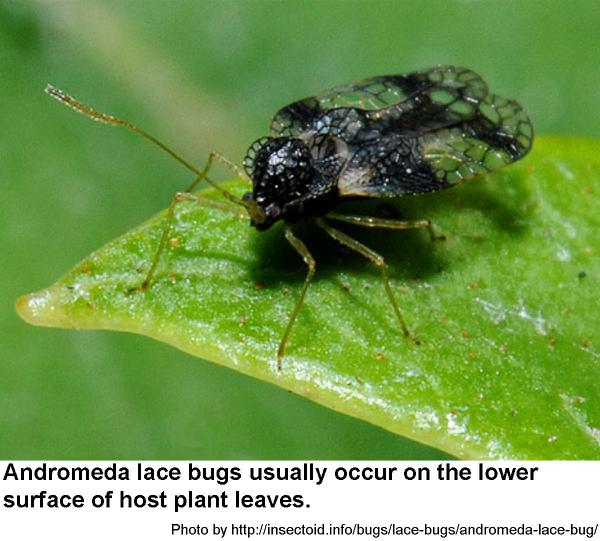Description and Biology
The andromeda lace bug, Sephanitis takeyai, is a relatively uncommon pest in North Carolina, although where it does occur, it can cause quite a bit of damage. The andromeda lace bug is a fairly showy lace bug that grows to about 1/8 inch long. Adults have an inflated "hood" that covers the top of the head. The head and wings are contrastingly marked with black and clear, colorless areas. By late winter, most adults and nymphs perish; this insect usually spends the winter in the egg stage inside the leaf. Eggs are usually inserted into the tissue of a young leaf causing a tiny watery blister beneath a shiny, dark, varnish-like drop of excrement. Nymphs are almost colorless at hatching but are soon dark and spiny. They molt five times before becoming adults. Andromeda lace bugs, eggs, and nymphs are found on the undersides of leaves. We have at least four generations per year in North Carolina, and they are active between May and September. The first generation causes the most damage.
Host Plants
Japanese andromeda (Pieris japonica) is susceptible to the andromeda lace bug. It is rarely found on azalea, leucothoe, and rhododendron. Mountain Andromeda (Pieris floribunda) is highly resistant to this lacebug, and it should be utilized in place of Japanese andromeda wherever possible. Feeding injury is is apparent on the upper leaf surface as severe yellow to gray stippling.
Residential Recommendations
Consider using mountain andromeda as an alternative to Japanes andromeda in the landscape. Apply pesticides to the undersides of the foliage for best management. Applications of horticultural oil (at the summer rate) or insecticidal soap work well when applied to the leaf undersides. More than one application may be necessary as new eggs hatch. Soil-applied systemic imidacloprid can also be very effective, apply after bloom of infected plants whenever possible to reduce the potential for impact on pollinators.
References
- Andromeda Lace Bug. Childs, R. 2011 (revised). UMassAmherst, The Center for Agriculture, Food, and the Environment.
- Control of the Andromeda Lace Bug and the Holly Leaf Miner. Schread, J. C. 1953. Connecticut Agr. Exp. Sta. Bull. 568. 13 pp.
- Control of Lace Bugs on Broadleaf Evergreens. Shread, J. C. 1968. Bulletin 684 of the Connecticut Agricultural Experiment Station, New Haven. 13 pp.
- Lace Bugs, Frank, S. D. and S. Bambara. 2009 (revised). Entomology Insect Notes. NC State Extension Publications.
- The Lace Bugs (Hemiptera: Tingidae) of North Carolina and Their Hosts. Horn, K. F., C. G. Wright, and M. H. Farrier. 1979. NC Agr. Exp. Sta. Tech. Bul. 257. 22 pp.
- Extension Plant Pathology Publications and Factsheets
- Horticultural Science Publications
- North Carolina Agricultural Chemicals Manual
For assistance with a specific problem, contact your local Cooperative Extension Center.
This Factsheet has not been peer reviewed.
Publication date: April 8, 2017
Revised: Oct. 26, 2019
Recommendations for the use of agricultural chemicals are included in this publication as a convenience to the reader. The use of brand names and any mention or listing of commercial products or services in this publication does not imply endorsement by NC State University or N.C. A&T State University nor discrimination against similar products or services not mentioned. Individuals who use agricultural chemicals are responsible for ensuring that the intended use complies with current regulations and conforms to the product label. Be sure to obtain current information about usage regulations and examine a current product label before applying any chemical. For assistance, contact your local N.C. Cooperative Extension county center.
N.C. Cooperative Extension prohibits discrimination and harassment regardless of age, color, disability, family and marital status, gender identity, national origin, political beliefs, race, religion, sex (including pregnancy), sexual orientation and veteran status.



